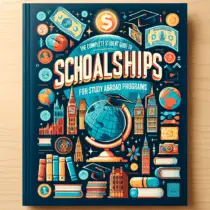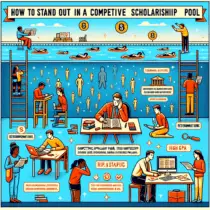Studying abroad is a life-changing experience that enriches a student’s education and broadens their perspective. However, the financial costs can be a significant barrier for many. Fortunately, scholarships designed specifically for study abroad programs can alleviate these expenses. This comprehensive guide offers valuable information on the various types of scholarships, tips on how to apply, and resources that can assist students in their pursuit of international education.
Understanding Types of Scholarships
Scholarships for studying abroad generally fall into several categories: merit-based, need-based, program-specific, and region-specific scholarships. Understanding these categories can help students identify which scholarships are most applicable to their situation.
Merit-Based Scholarships
Merit-based scholarships are awarded based on academic achievements, extracurricular involvement, leadership qualities, and other personal accomplishments. Students often need high grades, impressive resumes, or noteworthy standardized test scores to qualify.
Need-Based Scholarships
These scholarships are designed for students who require financial aid to participate in a study abroad program. Applicants typically need to provide financial documents that prove their need for assistance. Many organizations, both public and private, offer need-based scholarships to ensure that students from all economic backgrounds have an opportunity to study abroad.
Program-Specific Scholarships
Various study abroad programs and institutions offer scholarships specifically for their students. These scholarships may cover a portion or all of the program’s costs. Often, these are specific to the field of study, and applicants may need to demonstrate interest or commitment to a particular academic discipline.
Region-Specific Scholarships
These scholarships target students who plan to study in particular regions or countries. Governments, universities, and organizations in those regions often sponsor them. They aim to foster international cooperation and understanding while encouraging students to learn about new cultures and languages.
Preparing to Apply
The application process for scholarships can be competitive and time-consuming. Proper preparation is crucial to standing out. Below are some essential steps students should take before applying.
Research Thoroughly
Begin by researching a wide range of scholarships. Use online databases, consult with school counselors, and attend scholarship fairs. Websites like StudyAbroad.com and the Institute of International Education (IIE) offer comprehensive lists of available scholarships.
Understand the Requirements
Each scholarship will have specific eligibility criteria and application requirements. Carefully read through these to determine if you qualify. Take note of deadlines, as missing one could mean forfeiting an excellent opportunity.
Gather Necessary Documentation
Most scholarships will require detailed documentation including transcripts, letters of recommendation, financial statements, and personal essays. Start gathering these documents early to ensure everything is in order when it’s time to apply.
Write a Strong Personal Statement
A compelling personal statement or essay can significantly boost your application. Use this opportunity to explain why you want to study abroad, how the experience will benefit your academic and personal growth, and why you are an ideal candidate for the scholarship.
Tips for a Successful Application
Submitting a successful scholarship application goes beyond meeting the basic requirements. Use these tips to enhance the quality of your application and improve your chances of receiving financial aid.
Be Thorough and Accurate
Ensure all sections of the application are filled out correctly and completely. Double-check information for accuracy and ensure that all required documents are included.
Solicit Strong Letters of Recommendation
Choose recommenders who know you well and can speak positively about your academic achievements and character. Provide them sufficient time to write quality letters and inform them about the scholarship’s requirements and deadlines.
Tailor Each Application
Customizing your application for each scholarship can make a significant difference. Use the personal statement to address how the specific scholarship aligns with your goals and qualifications.
Proofread
Spelling and grammatical errors can be detrimental to your application. Proofread all written components multiple times and, if possible, have someone else review them as well.
Major Scholarship Programs to Consider
While there are numerous scholarships available, some are particularly well-known and have broader eligibility criteria. Below are a few prominent scholarship programs for studying abroad.
Fulbright Program
The Fulbright Program offers research, study, and teaching opportunities in over 140 countries for recent graduates and graduate students. It is highly competitive and requires a strong academic record and a well-crafted project proposal.
Benjamin A. Gilman International Scholarship
This scholarship aids undergraduate students who are U.S. citizens and receive Federal Pell Grants. The Gilman Scholarship aims to encourage students from diverse backgrounds to study and intern abroad.
Boren Awards
The Boren Awards focus on studying less commonly taught languages in regions critical to U.S. interests. Graduate students can receive up to $24,000 in funding, while undergraduates can obtain up to $20,000.
Critical Language Scholarship (CLS) Program
The CLS Program offers intensive language instruction in 15 critical languages. It is a fully-funded overseas language and cultural immersion program for American students.
Erasmus+ Program
For students in European Union countries, the Erasmus+ Program offers opportunities for study, training, and internships across Europe. It is designed to help students enhance their skills and employability through international experiences.
Utilizing University Resources
Many universities have dedicated offices or advisors to assist students interested in studying abroad. Here are some ways students can leverage these resources.
Study Abroad Office
Most universities have a study abroad office that provides information on available programs and scholarships. Advisors can guide you through the application process and even offer workshops on writing essays and preparing for interviews.
Financial Aid Office
Consulting the financial aid office can help you understand how your current financial aid package applies to study abroad programs. They can also inform you about additional scholarships and grants.
Career Services
Career services can help you highlight your international experience in your resume and job applications. They might also have information on internship opportunities abroad that come with financial support.
Scholarships from Non-Profit Organizations and Private Foundations
In addition to scholarships offered by governments and universities, numerous non-profit organizations and private foundations provide financial aid for students who aim to study abroad.
The Fund for Education Abroad (FEA)
FEA offers scholarships of up to $10,000 to support students who are underrepresented in the study abroad population. They prioritize students with demonstrated financial need.
The Rotary Foundation
The Rotary Foundation offers scholarships for graduate students and professionals to study abroad in one of their six areas of focus, including peacebuilding and disease prevention.
The Tortuga Study Abroad Scholarship
Tortuga Backpacks offers a $1,000 scholarship for students dedicated to studying abroad. The application requires an essay on how studying abroad will enhance your education and future career.
Additional Resources and Opportunities
Beyond traditional scholarships, other funding options can supplement your study abroad finances.
Crowdfunding
Platforms like GoFundMe and FundMyTravel allow students to raise funds for their study abroad programs. Sharing your story and engaging with social networks can help you collect the necessary funds.
Part-Time Work and Internships
Some countries allow international students to work part-time. Inquire about visa regulations and seek part-time work or internships in your host country to help with daily expenses.
Government Grants and Loans
Check if your home country’s government offers grants or loans for studying abroad. In the United States, federal financial aid may be applied to certain study abroad programs.
Exchange Programs
University exchange programs often come with built-in scholarships or reduced tuition fees, making them a cost-effective way to study abroad.
The Long-Term Benefits of Studying Abroad
Investing in a study abroad program pays off in numerous ways beyond financial returns. The long-term benefits include:
Enhanced Career Opportunities
Employers value candidates with international experience, cultural sensitivity, and multilingual skills. Studying abroad can set you apart in the job market.
Personal Growth
Living in a new country fosters independence, adaptability, and problem-solving skills. These life lessons contribute significantly to personal development.
Academic Growth
Encountering different educational systems and learning environments broadens your academic horizons and adds value to your primary field of study.
Final Thoughts
While the financial aspect of studying abroad poses a significant challenge, scholarships can make this transformative experience accessible. By understanding the various types of scholarships, preparing diligently, and utilizing available resources, students can find the financial support they need. With thorough research, a well-prepared application, and a bit of perseverance, the dream of studying abroad can become a reality.






